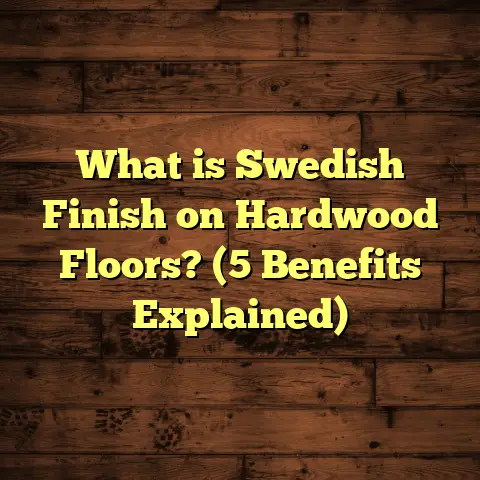What is Porcelain Tile Flooring? (5 Benefits You Should Know)
I can’t tell you how many times I’ve seen folks jump into flooring decisions without fully understanding what their options really mean for their homes. Flooring is one of those things that sticks with you—literally and figuratively—for years. It’s not like swapping out a lamp or a couch where you can change your mind easily. You want to get it right the first time because ripping out floors later is a headache nobody wants.
If you’re thinking about updating or installing new floors, you might want to seriously consider porcelain tile flooring. Why? Because it’s one of the most durable, stylish, and practical options out there, and yet so many people overlook it or don’t realize exactly what makes it special.
Let me walk you through what porcelain tile flooring really is, what goes into making it so resilient, and five key benefits that might just convince you to give it a shot. Plus, I’ll share some personal stories and data-backed insights from my years in the flooring business.
What Is Porcelain Tile Flooring?
At its core, porcelain tile flooring is a type of ceramic tile—but it’s made in a way that makes it much stronger and more water-resistant than regular ceramic. Porcelain is crafted from a refined clay mixture that often includes kaolin, feldspar, silica, and other natural minerals. This mix is pressed under extremely high pressure and then fired at very high temperatures—usually between 1,200 to 1,400 degrees Celsius (about 2,192 to 2,552 degrees Fahrenheit).
This manufacturing method creates a tile that is dense and vitrified (meaning it has a glass-like quality), which makes porcelain tiles much less porous compared to standard ceramic tiles. The low porosity means they hardly absorb any water—less than 0.5% by weight—which is a critical factor for durability and stain resistance.
Technically speaking, porcelain tiles have the following specs:
- Water Absorption: <0.5%, compared to 3-7% for ceramic tiles
- Density: Around 2.3 to 2.5 g/cm³
- Mohs Hardness: Approximately 7 (similar hardness to quartz)
- Firing Temperature: 1,200°C – 1,400°C
- PEI Rating: Usually PEI 4 or 5 for residential and commercial use, meaning they can handle heavy foot traffic
- Flexural Strength: Typically between 35 to 50 MPa (megapascals), indicating resistance to bending forces
The high firing temperature vitrifies the tile body, creating a hard surface that resists scratches, stains, and moisture penetration better than most other flooring materials.
How Are Porcelain Tiles Made? A Closer Look
Understanding the manufacturing process helps explain why porcelain tiles last so long and perform so well.
- Raw Material Selection: Manufacturers start with carefully selected clays and minerals such as kaolin (a fine white clay), feldspar (which lowers the melting point), quartz/silica (adds strength), and sometimes ball clay for plasticity.
- Mixing and Grinding: The raw materials are ground finely and mixed into a uniform slurry or powder blend.
- Forming: The mixture is shaped into tiles using either dry pressing or extrusion methods. For porcelain tiles, dry pressing is most common because it compacts the material tightly.
- Pressing Under High Pressure: The tile blanks are pressed at pressures up to 30,000 psi (pounds per square inch). This step is crucial as it removes air pockets that can cause cracks during firing and increases density.
- Drying: Before firing, the tiles go through drying ovens to remove moisture content.
- Firing: Tiles are fired in kilns at temperatures between 1,200°C and 1,400°C for several hours. This process vitrifies the body of the tile, making it dense and glass-like.
- Glazing (Optional): Some porcelain tiles are glazed with a surface coating that adds color, pattern, and extra protection against stains and scratches. Unglazed porcelain relies on the color running through the entire body (through-body porcelain).
- Finishing: Tiles may be polished, textured, or treated with anti-slip coatings depending on their intended use.
The combination of high pressure pressing and high-temperature firing makes porcelain tiles much tougher than regular ceramic tiles which are fired at lower temperatures and have higher porosity.
Porcelain vs Ceramic Tiles: Why Does It Matter?
People often confuse porcelain with ceramic since both come from clay and look similar. But here’s the key difference: porcelain tiles are denser, harder, less porous, and fired at higher temperatures than ceramic tiles.
This difference means porcelain is better suited for areas with heavy foot traffic or moisture exposure like kitchens, bathrooms, laundry rooms, even outdoor patios exposed to frost or rain.
Ceramic tiles tend to be softer and more porous, making them easier to chip or stain if used in high-traffic or wet areas.
Five Benefits of Porcelain Tile Flooring You Should Know
1. Durability That Stands Up to Life’s Demands
If you’re like me, you want a floor that can handle everything life throws at it: kids running around, pets scratching at doors, furniture being moved around—not to mention the occasional spill or dropped dish.
Porcelain tile flooring excels in durability because of its density and hardness. It scores about 7 on the Mohs hardness scale—that’s harder than glass and comparable to quartz countertops—which means it resists scratches and chips far better than hardwood or laminate floors.
What does this mean practically? I once installed porcelain in a family kitchen where three kids were constantly dropping toys and food all day long. Years later, their floor still looked as good as new with no visible damage or wear patterns.
According to data from the Tile Council of North America (TCNA), porcelain tiles hold up well under heavy residential and commercial foot traffic due to their high PEI rating (4 or 5). This means they’re built for durability in high-use areas.
Plus, porcelain’s strength also means fewer cracked tiles over time compared to more brittle materials like ceramic or natural stone.
2. Water Resistance Makes It Ideal for Wet Areas
One thing I always ask clients: “Are you looking for something that can stand up to moisture?” because water damage is one of the most common reasons floors fail prematurely.
Porcelain’s water absorption rate is less than 0.5%, which is significantly lower than regular ceramic tiles (3-7%) or natural stone like marble (which can be up to 20%). This low porosity means water simply doesn’t penetrate the tile body.
This makes porcelain perfect for bathrooms, kitchens, laundry rooms, entryways, mudrooms—and even outdoor patios where rain or snow exposure is constant.
I worked on a project in a northern climate where homeowners saw neighbors’ stone patios crack due to freeze-thaw cycles caused by moisture absorption. Their porcelain tile patio remained intact without any damage after many winters.
This resistance also helps prevent mold growth underneath floors since moisture can’t seep through easily.
3. Design Flexibility That Fits Your Style
You might think porcelain tiles come only in boring squares or plain colors—but technology has changed that entirely.
Thanks to advanced digital printing techniques like inkjet printing directly onto tile surfaces before glazing/firing, manufacturers can replicate almost any look you want—from realistic wood grains and marble veins to concrete textures and intricate mosaics.
I had a client who loved the look of hardwood but had three energetic dogs that would scratch up wood floors quickly. We chose wood-look porcelain tiles instead—they got the warm wood appearance without worrying about pet damage or stains.
Porcelain tiles come in all sorts of sizes too—small mosaics for backsplashes or shower floors, large-format slabs for seamless looks in living rooms or kitchens. This flexibility lets you get creative with patterns like herringbone or checkerboard without sacrificing durability.
4. Low Maintenance Saves Time and Money
One of my favorite things about porcelain tile flooring is how little work it requires once installed.
Unlike hardwood that needs refinishing every several years or carpet that traps allergens/dirt requiring deep cleaning regularly, porcelain just needs routine sweeping/vacuuming and occasional damp mopping with mild detergent.
Its dense surface doesn’t harbor dust mites or bacteria either, making it great for allergy sufferers.
I remember a client telling me after installing porcelain floors: “I can’t believe how easy it is to keep these clean—no stains from wine spills or muddy shoes!”
The glaze on some porcelain tiles adds an extra layer of protection that resists stains from coffee, oil, even harsh chemicals used in kitchens.
5. Long-Term Cost Efficiency
At first glance, porcelain tile installation might seem pricier than options like vinyl or laminate—but when you factor in longevity and fewer repairs/replacements over time, it often becomes more cost-effective overall.
Here’s a rough comparison based on industry averages:
| Flooring Type | Material Cost (per sq ft) | Installation Cost (per sq ft) | Lifespan (years) | Maintenance Costs |
|---|---|---|---|---|
| Porcelain Tile | $5 – $15 | $4 – $10 | 25+ | Low |
| Hardwood | $6 – $12 | $4 – $8 | 15 – 20 | Medium (refinishing) |
| Laminate | $1 – $5 | $2 – $6 | 10 – 15 | Low |
| Vinyl | $2 – $7 | $1 – $5 | 10 – 20 | Low |
| Carpet | $3 – $8 | $2 – $5 | 5 – 7 | Medium (cleaning) |
As you can see, while upfront costs might be higher for porcelain tiles compared to laminate or vinyl, the long lifespan combined with minimal maintenance makes it a smart investment.
When planning projects, I use FloorTally to get accurate cost estimates by inputting local labor rates and material prices. This helps manage budgets realistically without surprises later on due to waste or hidden costs.
My Personal Story with Porcelain Tiles
Early in my career as a flooring contractor, I installed porcelain tile flooring for a family renovating their kitchen. They wanted something stylish yet tough enough to handle three kids under five years old running around all day long.
We went with large-format matte-finish glazed porcelain tiles—these offered slip resistance but were still easy to clean spills from quick breakfasts or craft projects.
Five years later when I visited them again, their floors looked brand new—no chips, no cracks, no discoloration—even with pets knocking things over regularly.
That experience changed how I viewed flooring materials—it showed me that investing in better quality upfront really pays off in durability and peace of mind down the road.
Deeper Insights from Industry Research & Case Studies
The Tile Council of North America conducted a study tracking over 200 residential flooring installations spanning more than 15 years. Their findings? Porcelain tile floors exhibited less than a 2% failure rate due mostly to installation errors rather than material defects—which speaks volumes about how reliable the material itself is.
Additionally, research published by the Natural Stone Institute compared maintenance costs across various flooring types over time. Porcelain consistently required up to 60% less maintenance expense throughout its lifespan compared with engineered hardwood or natural stone flooring.
One commercial case study involved a retail store transitioning from vinyl floors to porcelain tiles. After eight years under heavy customer traffic conditions:
- Cleaning time was reduced by half
- Replacement costs dropped to zero
- Customer satisfaction regarding floor appearance increased significantly
Such data confirms what I’ve seen firsthand: porcelain delivers long-term performance and value beyond initial impression costs.
Addressing Common Questions About Porcelain Tile Flooring
Is Porcelain Tile Cold Underfoot?
Yes—it tends to feel cooler than hardwood or carpet because it doesn’t retain heat well. But if you live somewhere cold or want extra comfort underfoot during winter months, installing radiant floor heating beneath porcelain tiles solves this issue beautifully.
Are Porcelain Tiles Slippery When Wet?
Some glazed porcelain tiles with glossy finishes can be slippery when wet—especially in bathrooms or kitchens. To avoid falls:
- Choose textured or matte-finished tiles
- Use anti-slip coatings when necessary
- Add rugs or mats near wet areas
How Difficult Is Installation?
Porcelain’s density makes cutting more challenging than ceramic tiles—you’ll need specialized wet saws with diamond blades for clean cuts without cracking edges.
Proper subfloor preparation is key too; uneven surfaces can cause tiles to crack later on due to stress points.
That’s why hiring an experienced flooring professional matters—a poorly installed floor will lead to costly repairs down the line regardless of material quality.
Can Porcelain Tiles Be Used Outdoors?
Absolutely! Thanks to low water absorption rates and frost resistance properties, porcelain performs well outdoors in patios, walkways, pool surrounds—even in freezing climates provided proper installation techniques are followed (like using frost-resistant adhesives).
Tips from My Experience: How To Get The Best From Porcelain Tile Floors
- Invest in Quality Installation: Don’t skimp on skilled labor—it makes all the difference in how long your floors last without issues.
- Choose Appropriate Tile Finishes: For wet areas opt for matte/textured finishes; glossy tiles work better in dry spaces.
- Consider Large Format Tiles for Fewer Grout Lines: This reduces maintenance effort and gives a modern seamless look.
- Use Grout Sealer Regularly: To protect grout lines from stains and moisture.
- Plan Your Budget with Tools Like FloorTally: It helps me estimate costs accurately factoring materials, labor rates, waste percentages—avoiding surprises during projects.
- Think About Underfloor Heating if You Live in Cold Areas: Makes porcelain floors much more comfortable year-round.
- Don’t Forget Transition Strips: Between rooms with different floor types—they protect edges and improve appearance.
Final Thoughts
Porcelain tile flooring offers an unbeatable combination of toughness, water resistance, style versatility, low maintenance, and cost-effectiveness over time. Whether you’re renovating your kitchen, upgrading your bathroom floors, or looking for durable outdoor options—porcelain holds up well against everyday wear while adding elegance to your space.
From my personal experience working on countless projects over many years—and backed by industry research—I’m confident saying porcelain tile is one of the smartest investments you can make in your home’s flooring.
If you want durable beauty with minimal fuss down the road—and peace of mind knowing your floors will last decades—porcelain tile deserves serious consideration.
If you want help planning your next project budget-wise or choosing materials based on your needs—just ask! I’ve found tools like FloorTally invaluable for crunching numbers quickly while keeping everything realistic—and I’d be happy to share tips from my experience too.
So… what kind of floor do you think would suit your space best? Are you leaning toward porcelain now after hearing all this? Feel free to chat—I’m here whenever you’re ready!





